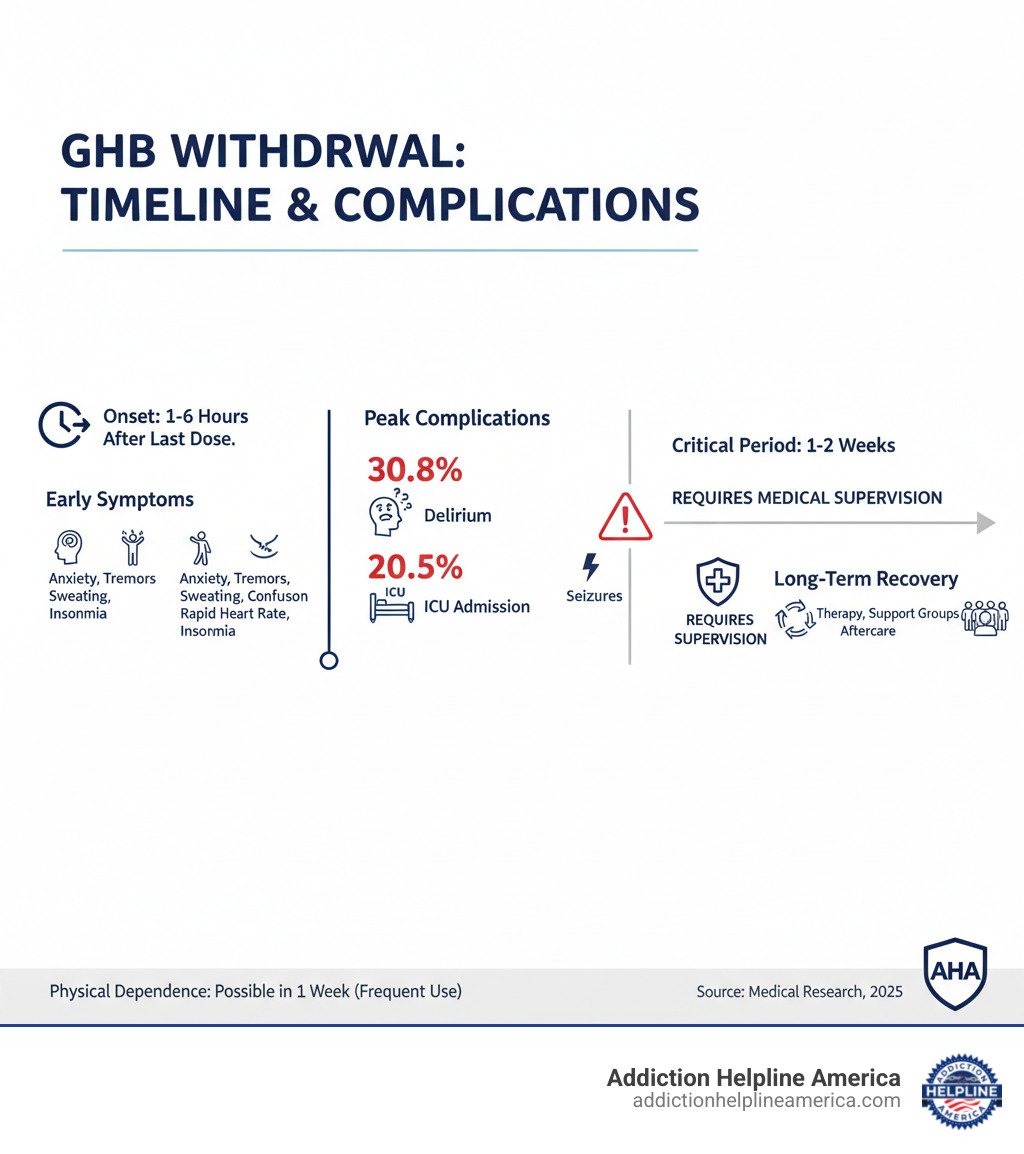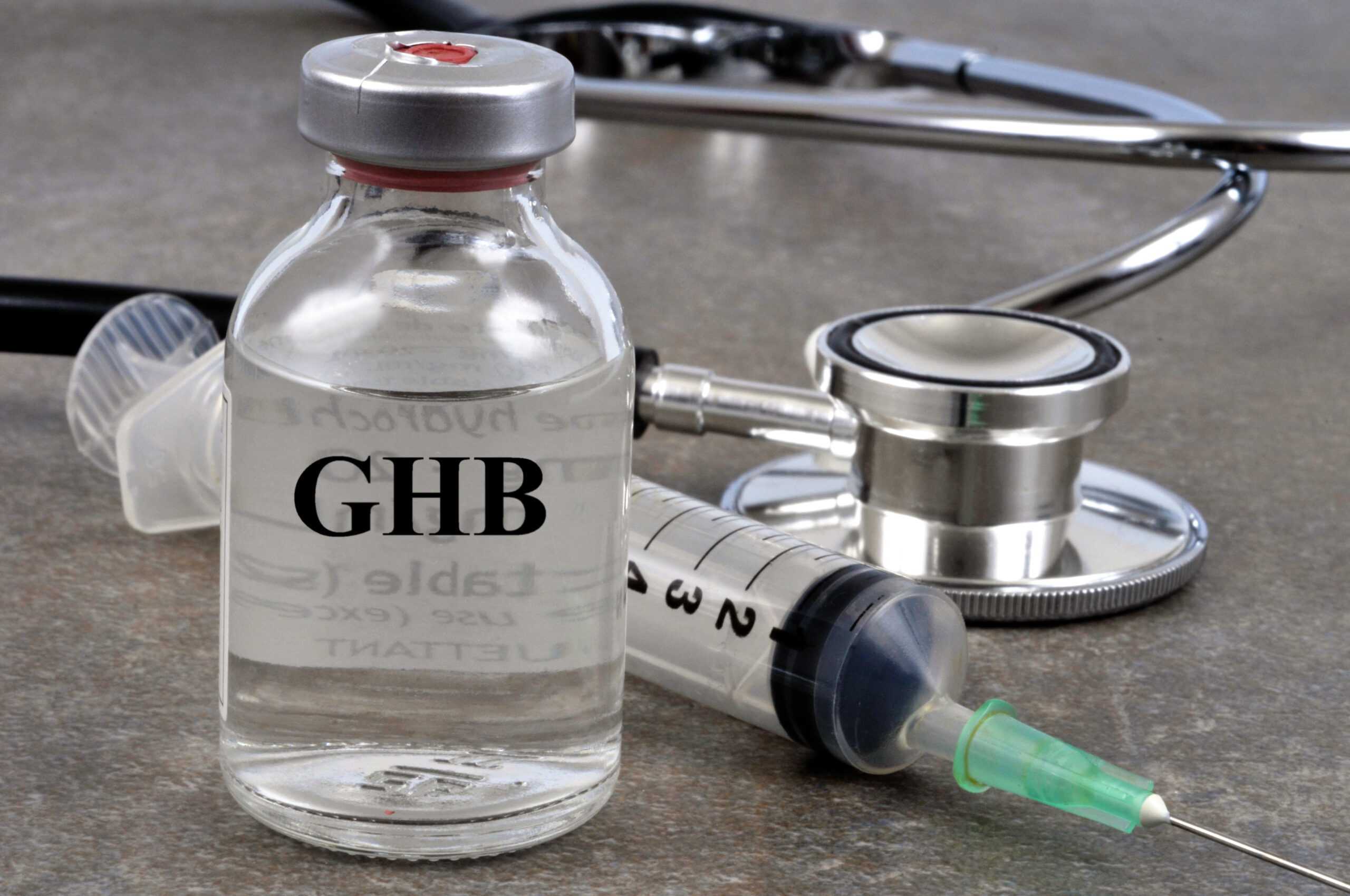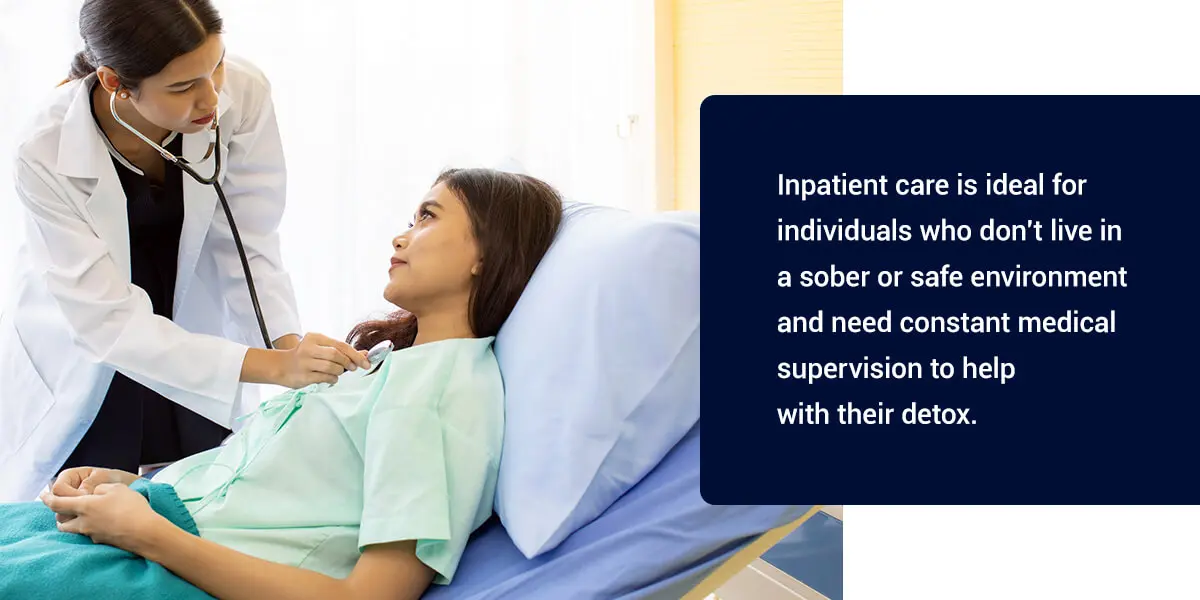Your Journey to a Healthier Life Starts Here
Free Insurance Verification
Verify Your Treatment Coverage
Verify Your Treatment Coverage
GHB Treatment is a specialized form of addiction care designed to safely manage withdrawal from gamma-hydroxybutyrate (GHB), a powerful central nervous system depressant. This process requires immediate medical supervision due to life-threatening complications that occur in nearly one-third of patients.
What You Need to Know About GHB Treatment:
First synthesized in 1874, GHB’s recreational use surged in the 1980s. Its danger lies in its odorless, tasteless, and colorless form and a narrow safety margin: the dose for relaxation is perilously close to one causing unconsciousness, coma, or death.
GHB withdrawal is uniquely severe and rapid, with symptoms appearing 1 to 6 hours after the last dose and quickly escalating to life-threatening levels. Physical dependence can form in as little as one week with frequent, around-the-clock use.
The severity is stark: studies show nearly half (46.2%) of people attempting GHB detox drop out prematurely. However, medically supervised treatment dramatically improves outcomes, with success rates up to 85% in programs using pharmaceutical GHB tapering.
At Addiction Helpline America, we’ve guided countless individuals through the complex journey of GHB Treatment, connecting them with specialized facilities equipped to handle these unique medical challenges. We understand that finding the right program can mean the difference between life and death.

This infographic details the rapid progression from GHB use to dependence (possible within 1 week of frequent use), the swift onset of withdrawal symptoms (1-6 hours after last dose), common complications (30.8% delirium rate, 20.5% ICU admission rate), and the critical importance of medical supervision throughout the 1-2 week withdrawal period.
Gamma-hydroxybutyrate (GHB) was first created in 1874. While the brain produces it naturally in tiny amounts, illicit GHB is a different beast. The DEA classifies illegal GHB as a Schedule I drug, like heroin, due to its high potential for misuse. A pharmaceutical version, Xyrem, is a controlled Schedule III drug for narcolepsy.
Street GHB is often made with dangerous chemicals like floor stripper, resulting in unpredictable and potent batches—up to 3,000 mg per dose. It typically appears as a clear liquid, white powder, tablet, or capsule.
GHB’s most dangerous quality is being odorless, tasteless, and colorless, earning it a reputation as a “date rape drug.” Its deadly nature is compounded by a narrow dose-response window, where the amount causing euphoria is dangerously close to a fatal dose. Effects begin in 10-15 minutes and last 3-7 hours.
Mixing GHB with alcohol or other depressants is extremely dangerous, as the combination can shut down the central nervous system completely.

Take the first step towards a healthier life! Call now to connect with our compassionate team and start your recovery journey today. Your path to healing awaits!
Our recovery specialists are available 24/7 to provide support, and all calls are confidential and free. Reach out anytime – we’re here to help!
Recognizing GHB addiction involves observing patterns over 12 months, as defined by the DSM-5. Key signs include:
This is exactly why GHB Treatment requires such specialized care. The addiction develops quickly, the physical dependence is severe, and the consequences of unsupervised withdrawal can be fatal.
While GHB addiction can affect anyone, certain groups face higher risks:
These overlapping challenges highlight why effective GHB Treatment must be comprehensive, addressing not just the addiction but also co-occurring conditions and underlying life circumstances. At Addiction Helpline America, we connect people with programs equipped to handle these complex needs.
GHB withdrawal is notoriously severe and dangerously rapid. When a dependent person stops using, their central nervous system becomes hyperexcitable, with symptoms beginning just 1-6 hours after the last dose. This process can quickly escalate into a medical emergency over the following 1-2 weeks, making professional intervention essential. It is not something that can be managed at home.

The statistics on GHB withdrawal complications are alarming:
Attempting to detox from GHB at home is extremely dangerous and can be fatal. Medical detox is essential for several reasons:
The unique and severe challenges of GHB withdrawal underscore why specialized GHB Treatment is not optional—it’s a necessity for survival. For a deeper understanding, you can explore scientific research on GHB withdrawal syndrome.
At Addiction Helpline America, we know how frightening these statistics are. The good news is that with proper medical care, people successfully steer withdrawal and build lasting recovery. You don’t have to face this alone.
At Addiction Helpline America, we know that true recovery from GHB addiction requires a comprehensive, multi-stage approach. After the critical first step of medical detox, rehabilitation and ongoing support are needed to address the psychological and social factors behind the addiction. While the principles are similar to other addiction treatments, the medical detox phase for GHB is far more intensive due to its severe withdrawal risks. With the right support, recovery is entirely possible.
Medical detox is the first and most critical step in GHB Treatment, designed to stabilize the body and manage severe withdrawal symptoms under medical supervision. Medications are essential for safety and comfort:
All medication decisions are made by experienced medical professionals. For more clinical details, see expert insights on GHB Toxicity Treatment & Management.

After detox, rehabilitation helps rebuild your life. Different levels of care are available to match individual needs.
Therapy addresses the root causes of addiction. Common evidence-based approaches include:
Integrated treatment is crucial for addressing co-occurring mental health disorders or polysubstance use simultaneously. At Addiction Helpline America, we connect you with facilities that specialize in the unique challenges of GHB addiction and can support you through every step of this journey.
Completing a primary GHB Treatment program is a huge achievement, but it’s the start of a lifelong journey. Long-term recovery depends on aftercare and building a fulfilling life that makes returning to GHB undesirable. This is especially true for GHB recovery, as the brain needs time to heal and relearn how to function without the drug. This process requires patience and a strong support system.

Sustaining recovery involves several key elements:

Take the first step towards a healthier life! Call now to connect with our compassionate team and start your recovery journey today. Your path to healing awaits!
Our recovery specialists are available 24/7 to provide support, and all calls are confidential and free. Reach out anytime – we’re here to help!
A solid aftercare plan, created before leaving treatment, is vital for a successful transition.
Recovery is a process of progress, not perfection. With the right tools and support, you can build a life free from GHB. At Addiction Helpline America, we’re here to help you find the ongoing support and resources you need to thrive in recovery.
When you’re facing GHB Treatment decisions for yourself or a loved one, you likely have urgent questions. We hear these concerns every day at Addiction Helpline America, and we want to provide you with clear, honest answers that can help guide your next steps.
GHB withdrawal is extremely dangerous because it is severe, rapid, and unpredictable. Symptoms can begin within hours of the last dose and quickly escalate to life-threatening complications. Nearly a third of patients experience delirium, and one in five requires intensive care. The risk of seizures, respiratory failure, and cardiovascular collapse is high, making it a medical emergency that requires constant monitoring.
No. Attempting to detox from GHB at home is extremely dangerous and can be fatal. The severe medical complications can appear suddenly and escalate within hours. A home environment cannot provide the 24/7 medical supervision, vital sign monitoring, and emergency medications needed to manage risks like seizures, delirium, or respiratory failure. Medically supervised detoxification in a hospital or specialized facility is the only safe and responsible choice.
The primary difference is the intensity and specialization of the medical detox phase. GHB withdrawal is uniquely severe, with a rapid onset and a high rate of complications like delirium that often require ICU-level care. Treatment providers need specific experience with GHB protocols, which may involve high-dose benzodiazepines, baclofen, or pharmaceutical GHB tapering. This level of medical management is far more intensive than for many other substances, making it crucial to find a facility that specializes in GHB Treatment.
GHB addiction is a life-threatening condition defined by a rapid path to dependence and a uniquely dangerous withdrawal. Statistics show that nearly a third of patients experience delirium and 20.5% require intensive care. Attempting to detox alone is not an option.
But here is the most important truth: recovery is absolutely possible. With specialized medical care and comprehensive support, thousands have overcome GHB addiction and built fulfilling lives.
At Addiction Helpline America, we provide free, confidential guidance to connect you with the right GHB Treatment program. Our network includes facilities equipped to handle the specific medical demands of GHB withdrawal, giving you the best chance at lasting recovery.
Time is critical with GHB, as withdrawal begins within hours. Making the first call is the most important step. You don’t have to face this alone. We’re here to guide you from addiction to freedom.
Find a personalized GHB treatment program today. Your journey to recovery starts now, and we’re here to help you take that first step.
Are you or a loved one struggling with addiction? Call today to speak to a treatment expert.
Calls to any general helpline will be answered or returned by one of the treatment providers listed, each of which is a paid advertiser:
Our helpline is available 24 hours a day, 7 days a week at no cost to you and with no obligation for you to enter into treatment. We are committed to providing support and guidance whenever you need it.
In some cases, Addiction Helpline America charges our verified partner a modest cost per call. This fee helps us cover the costs of building and maintaining our website, ensuring that we can continue to offer this valuable service to those in need.
Calls to the general helpline will be answered or returned by one of the listed treatment providers, all of whom are paid advertisers.
By using the helpline, you agree to the terms of use. We do not earn any commission or fee based on the treatment provider selected by the caller, and there is no obligation to pursue treatment.
This service is not affiliated with Alcoholics Anonymous World Services, Inc.